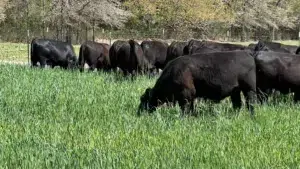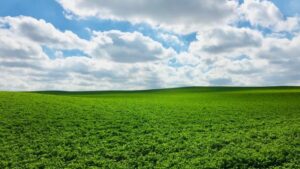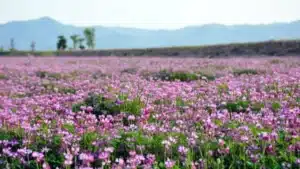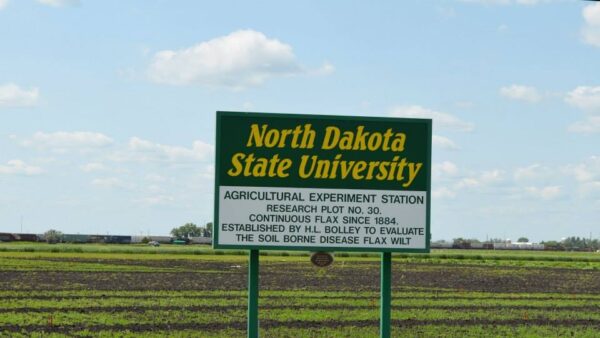
Whether it’s new conventional varieties with better winter hardiness and disease resistance, or a new GE product with herbicide resistance and improved fibre digestibility, there’s a lot happening in the alfalfa seed market. Here’s a snapshot of the latest advances and what’s coming down the pipe.
In the world of forage seed, alfalfa is getting a lot of press these days, due in part to a GE variety that has sparked renewed interest in the world of alfalfa seed.
Even before the U.S.-based Forage Genetics International (FGI) began selling its HarvXtra alfalfa seed with Roundup Ready technology to farmers in Eastern Canada in 2016, the alfalfa industry was split on the issue of whether doing so was a good idea.
On one side, alfalfa seed producers in the West feared contamination risk they said could pose a danger to alfalfa seed exports. In the East, growers wanted the ability to grow herbicide tolerant alfalfa for livestock feed.
In the end, FGI decided to go ahead and launch the product in the East for hay production only. It’s currently not being sold in Western Canada. Despite the controversy, the issue served to put alfalfa back in the spotlight.
“It’s what often gets lost when people talk about alfalfa — the conventional side and some of the strides being made there,” says Erick Lutterotti, general manager of Gold Medal Seeds in Brooks, Alta. (a subsidiary of FGI) and vice-chair of the Canadian Seed Trade Association’s Forage and Turf Committee.
Winter Hardiness
Especially exciting for Lutterotti are new varieties of multifoliate alfalfa that have been bred to be very winter hardy.
“That’s the big thing in conventional alfalfa.”
Winter hardiness is determined by an alfalfa variety’s ability to withstand cold temperatures. The lower the rating for winter hardiness, the greater the ability of the plant to survive the winter months. Winter hardiness ratings indicate the potential longevity of the alfalfa stand.
Lutterotti notes that although fall dormancy is related to winter hardiness, the latter is separate from fall dormancy. In recent years, breeders have been successful at separating winter hardiness from fall dormancy.
“In the past, multifoliate alfalfas came with a 4 or 5 fall dormancy rating, meaning it wakes up early and goes to bed late. For people south of Lethbridge, you’d get three or four cuts per year, maybe a fourth,” Lutterotti says.
“Inherently, creeping-rooted alfalfa was the most winter hardy there was, but those varieties were best suited for lower-yielding two-cut systems. Now we have a very high-quality alfalfa — dairy quality — that’s still at that 4 fall dormancy rating, but you have a winter hardiness below 2, which is as a good or better than any creeper on the market. This gives you lots of options as to your farming system, and it can be used in many different regions.”
Regional differences are the key to knowing what alfalfa variety is best for Western Canada, Lutterotti adds. If the alfalfa crop is meant for short-term growth, moderate winter hardiness is usually adequate. For long-term stands, a lower winter hardiness rating is often a good idea, but it can depend on a couple factors, he notes.
“In regions with more snow, a lower winter hardiness rating may not provide much additional protection, but you never know. You don’t want the grower to just assume that they’re going to get a lot of snow cover next winter. You might not get as much snow in a given year, so it might be a good idea to go with an alfalfa that can withstand exposure to the cold better.”
He recommends retailers work with their customers to determine the variety that is the best fit for their specific situation. Popular varieties include Compass, with ultra-winter hardiness and fast regrowth.

Improving Yield, Persistence and Quality
The advances in alfalfa products like high-quality winter hardy varieties are due in part to the hard work of people like Annie Claessens, forage breeder at Agriculture and Agri-Food Canada’s Quebec Research and Development Centre.
Claessens is part of a multidisciplinary team of researchers constantly working to improve the forage crop on a number of fronts.
Like breeders of most other crops, alfalfa breeders are working to boost yields. The key to doing so is lowering the dormancy, but doing so can have unwanted effects on alfalfa persistence. It’s an interesting conundrum that Claessens and her team are challenged with.
“We’re trying to help growers extend the alfalfa growing season from late summer through to early winter, so we want less dormant cultivars. However, when they’re less dormant, they generally have lower winter survival.”
Some significant gains have been made in recent years, like the kind Lutterotti refers to, where winter hardiness has been improved while keeping fall dormancy the same. But there’s a ways to go, Claessens notes.
“Those two traits can be improved simultaneously. We’ve developed an indoor selection method to decrease dormancy but increase freezing tolerance, which is one of the most important factors in lowering winter survival under our climatic conditions.”
Breeding for better freezing tolerance involves creating plants with perennial organs (crown and roots) that are able to withstand freezing temperatures. She reports that they have been able to increase the freezing tolerance of alfalfa by 5 C.
Claessens and her colleagues are also working at disease resistance, which is the second most important factor lowering winter survival. Breeding efforts are focusing on Phytophthora root rot and Aphanomyces root rot, thereby helping alfalfa to be less affected by cold and wet soil conditions.
Phytophthora root rot, caused by a fungus-like pathogen, is believed to survive for many years in the soil, and may attack alfalfa after long rotations to other crops. Aphanomyces root root, caused by a pathogen very similar to Phytophthora, attacks both seedlings and adult alfalfa plants and can dramatically reduce yield and vigour of established stands.
“We’ve developed an indoor selection method to identify which plants are highly and moderately resistant to those diseases. We can select plants with greater resistance and breed them to rapidly develop lines that are better able to resist those pests.”
Boosting quality also remains the mission of alfalfa breeders like Claessens.
“Our goal is to have cows produce more milk from the alfalfa they consume, either by increasing alfalfa’s digestibility or energy content so the microorganisms in their stomach can have more energy to process the protein,” she says. “By increasing the energy content, we can increase milk production from forages, increase protein content of the milk, and reduce nitrogen loss in the environment at the same time.”
Exciting new alfalfa varieties don’t just appear overnight, though. Claessens notes that breeding programs are expensive, and new sources of germplasm and funding are always being sought. It can take many years for a new alfalfa variety to hit the market.

The GE Arena
GE alfalfa often nabs headlines, and for good reason — FGI’s Roundup Ready alfalfa product introduced in Eastern Canada is the first herbicide-tolerant alfalfa to hit the market, and has made life easier for hay producers looking to eliminate weeds quickly and easily. It also has the benefit of being a reduced lignin alfalfa, meaning it has better digestibility than varieties with higher lignin levels.
It’s not the only low-lignin alfalfa on the market, though — in 2015, Alforex Seeds introduced its Hi-Gest 360 and Hi-Gest 660 alfalfa offerings, which contain a low-lignin trait developed through conventional breeding.
HarvXtra alfalfa with Roundup Ready Technology is FGI’s most recent foray into the Canadian alfalfa market, and contains both the Roundup Ready trait and a reduced-lignin trait also developed through transgenic methods.
Interestingly, the two companies are now embroiled in a legal battle — FGI filed suit April 17 in U.S. District Court against Alforex Seeds, alleging that Alforex makes false and misleading claims in its advertising and promotional materials in violation of federal and state law. The suit alleges that Indiana-based Alforex promotes its Hi-Gest alfalfa as a low-lignin variety that is comparable or superior to FGI’s HarvXtra alfalfa reduced-lignin trait, when it is only comparable to conventional alfalfa varieties already on the market.
In addition to the lignin content claims, the suit alleges that Alforex highlights a potential for delayed harvest that research does not support and that it misleadingly implies that alfalfa grown from Hi-Gest seed promotes easier digestion and enhanced performance for livestock.
At this time, HarvXtra alfalfa with Roundup Ready Technology is available only to growers in Eastern Canada and is confined to the sale of seed for hay production. Companies are not permitted to undertake HarvXtra alfalfa with Roundup Ready Technology seed production in Canada. All seed production has taken place in the U.S., with only commercial sales for hay production allowed in Eastern Canada.
“The reduced lignin trait is more important than the Roundup herbicide resistance, in my opinion,” says Mike Peterson, global traits lead for FGI. “The Roundup Ready trait is a nice add, but it’s not the main feature driving the sales of this product in Canada. The HarvXtra always comes first when we describe the product.”
GE alfalfa isn’t the only product FGI is working on. It’s also making strides with conventional alfalfa, an example being an attempt to offer stronger resistance to Anthracnose stem rot.
Anthracnose of alfalfa is caused by Colletotrichum trifolii. This fungus can attack leaves, but most characteristically attacks stems and crowns. While resistance has been built in to many varieties of alfalfa on the market, Peterson notes it’s beginning to break down in some lines. The disease is rare in Western Canada, but is more prevalent in the eastern United States and Eastern Canada.
“Even with Aphanomyces root rot, which has been around for over 20 years, the industry is finding there’s still la lot to be gained by breeding new varieties resistant to additional races of this important disease,” he adds.













